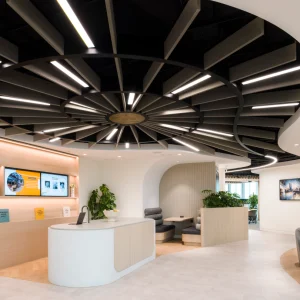
Since the completion of the Jewish Museum Berlin in 1999, Studio Daniel Libeskind has been globally positioned as the prevalent practice with an intrinsic ability to design in response to history or trauma for a specific need of memorialisation. Libeskind’s ability to recount tales of loss and tragedy through the built environment creates powerful emblems of memory which often resist or repel conventional methods or ideology. His most recognisable contributions include the Imperial War Museum North, Manchester (2001); Contemporary Jewish Museum, San Francisco (2008); and, the Military History Museum, Dresden (scheduled completion- 2011). The Jewish Museum Berlin, his first full commission, remains a pivotal moment; not only did he glean an opportunity to put academic theory into professional practice, it continues to enable him to orient his own career and its subsequent trajectory. This self-orientation allows for references to the museum in direct relation to his most prescient projects, most notably the Ground Zero, World Trade Center masterplan. In conversation with Daniel Libeskind in his Lower Manhattan office, within walking distance of the World Trade Center site, what becomes apparent is that the architect is a fervent believer in the possibilities of architecture– not simply in regenerative terms but in emotive, historiographical, communicative and symbolic expression – and the profession’s inherent ability to call upon its own heritage to speculate, experiment and invent.

‘Why do we build in the first place?’ Libeskind asks. ‘It is about an idea. It is about human beings. It isn’t just about containers. Very often, the discussion in architecture from the Sixties right through to the Nineties has been more about typologies, forms, cladding, shimmering surfaces or fashions. But, the eternal question is how do people live, how do they orient themselves to where they are in the world?’
In 2003, just 18 months after the terrorist attacks, Libeskind’s Memory Foundations proposal was selected as winner for the Ground Zero redevelopment. It accommodates 10 million sq ft (930,0000 sq m) of office space, a memorial area, and ground-level retail units and designates a significantly large area to public space. The overall project has an estimated completion date of 2014, however, certain elements such as Michael Arad’s 9/11 Memorial are to be completed imminently as part of the commemoration of the tenth anniversary.
Libeskind claims: ‘All the abstractions of urban planning and architecture come to the fact that at the centre more than half of the 16 acre space is public space, which is not easy to achieve when you have 10 million sq ft of density, more millions of square feet of infrastructure, or cultural elements. I often say it is a whole city.’
In among the 20 or so governing bodies claiming stakehold on the World Trade Center redevelopment site lies the rebirth of the monument to American capitalism. In a singular monumental icon, Libeskind’s Freedom Tower amalgamates the hyper-politicised construction process with a building that ultimately produces a political symbol of Western democracy. Libeskind states: ‘I believe democracy is not easy, you have to divide consensus.’ In this double-bind of politics, the Freedom Tower included the representation of the capitalist and democratic system through its iconological referencing; particularly, the asymmetrical form as reference to the Statue of Liberty and the Tower’s height (1,776ft) alluding to the date of the American Declaration of Independence – references that have stoutly remained.
When undertaking a project on the political and economic scale of Ground Zero, it is not surprising that it is littered with difficult decisions and negotiation. Similarly, the Jewish Museum Berlin had to endure political and social uneasiness and questioning, just as both projects carried with them a deep responsibility of reinterpreting trauma. His reliance was on a strategy; based on inventing a programme – describing the oxymoron of attempting to understand an event that seems entirely implausible, and implementing and incorporating cultural edifice – he manifested a project that managed to make physical meaning from a historical tragedy.
‘Sure, you can define 1776 as a building height, but those symbols that very often people think are trivial are not,’ Libeskind opines. ‘In everything there is a symbolic value: an inch is symbolic; a metre is symbolic; a second or an hour is symbolic. There is nothing in our world that is not already weighted in human experience. It is how to connect those deeper realities to a human experience. This can only be done through multiple ways. Ground Zero has a very important, if not very obvious, significance. But there is symbolic value in the Jewish Museum – will people ever understand the Jewish Museum? People said that it should not be built because there’s nothing Jewish about it. “Where is the Star of David?” or this or that. But, the true symbols, which are not superficial or done as a cartoon, have a profoundly informed sense of connectivity at all levels or dimensions of the human soul or intellect and do communicate’.

At Ground Zero, a prescient example, akin to the voids’ insinuating presence through absence at the Jewish Museum Berlin or Imperial War Museum North, is the foundation Slurry Wall which tries to infuse the idea that an entity has disappeared and reappears ephemerally: ‘To construct something that is also hidden. We wanted to expose the foundations at Ground Zero. This act is very new – to show what the building is sitting on. It is not sitting on something hidden; it is sitting on the Slurry Wall. There is a truth in what remains and is exposed,’ he explains. ‘It will be an incredible experience for people to be in the bedrock of New York and to see how buildings relate to the emptiness of underground or the solidity of the ground. It is about disclosing something, that isn’t just more of the same. It shows something that may be even more important: survival.’
In a similar gesture, Libeskind evokes the human memory condition as a device to orient the viewer in both space and time. ‘I think [at the World Trade Center] people will see something that connects a memory with the future; something that connects the tragic, which will forever be inscribed into the site because it will always be a place where people died, but also it will show not only a resilience but the potential of the city to reinvent itself, to move forward and to do something meaningful which is not just some buildings in a grid, it is something that shapes the imagination. The mind is just the tip of it. It is based on so many things, particularly in architecture that we take for granted but can hardly fathom. Certainly that goes for memory because memory is an orientation. Memory is not a symbol.’
It is interesting to consider that even in the singular Jewish Museums of San Francisco and Berlin; and the war museums in Manchester and Dresden; memorialisation seems continually to differ in meaning. Is this through a stylistic shift, an aesthetic treatment or subtle, contextual juxtaposition? For instance, it could be said that the Jewish Museum Berlin is a decentralised form of memorialisation in the sense that it brought together disparate elements of history and accounts of the Holocaust for a number of separate, yet entirely entwined, tragedies. The Berlin or San Francisco Jewish Museums archive and collect memories from an array of locations. In contrast, the World Trade Center represents the precise locale of devastation: a centralised memorialisation, a rebuilding of the monument that once stood before. How, then, does Ground Zero mediate between the totality of oppressive, but possibly implicit, forces of memorialisation on the immediate site as opposed to memorialising genocidal regimes from disparate sites across a breadth of time? Does this question reveal a methodology of memorialisation?


‘A valid question,’ says Libeskind. ‘On the Lindenstrasse, where the Jewish Museum is, was the place from where Jews were taken to concentration camps or deported or murdered. The analogy of memory is overwhelming. But, these projects are so different. Their scale of building and programme make them different. We speak about architecture in the long term. That is the true scale of architecture. It is to orient us, really, in history. It is not to orient us just in terms of uptown or downtown… It is just to make sense. Does it make any sense, or is there any meaning that six million Jews were murdered? A chaotic fact has just happened. Does Ground Zero have a meaning? Well, I believe that Ground Zero does have a meaning. I believe that the attacks, all of it, have meaning. We might not fully know what it is but we can intuit how we can respond in a positive sense.’
The idea that architecture orients you in history is a fascinating thought: to consider architecture as a signifier, a point or place in time – whether that is something celebratory like a Gothic cathedral or a building steeped in trauma like the World Trade Center – the building will always account for an historical act. It almost lays testimony to the fact through its physical manifestation. Libeskind, commendable not least for being the eternal optimist, has crafted a career based around an ideology that moves beyond the fetishistic and strives to subliminally charge architecture with inherent meaning. His body of work exemplifies a sense of balance between diplomacy and pragmatism, whether it is in the thematising of programme or in the actuality of the building process. He invokes a plurality for ways of seeing, just as his early drawings intricately displayed obtuse angles and impossible geometry, they ultimately become a coherent composition; the World Trade Center alongside the plethora of memorialisation projects aims at promoting a positive response to inhumane travesties: ‘You cannot be a pessimist in architecture; it goes against the grain of construction because it is an act of affirming something. It is not a negation,’ Libeskind says. Yet, concurrently, he observes that through the process of affirmation: ‘We still have to build in such a way that means we have to dig the ground, lay a ground stone, somebody has to do something violent.’





